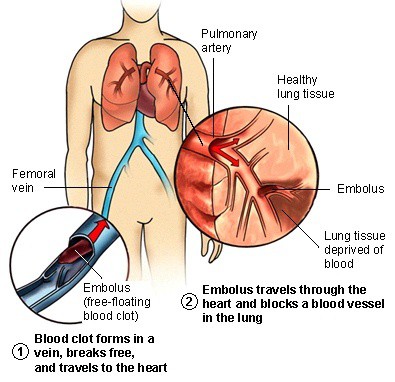Serena Williams undergoes emergency treatment for pulmonary embolism

Tennis great Serena Williams is undergoing emergency treatment as a result of a pulmonary embolism (blood clot in the lungs). The 29 year old has had a rough time since cutting her foot on broken glass in a restaurant in Munich on July 7. Williams was wearing sandals, and received deep cuts on both feet. The injury also lacerated a tendon on the top of her right foot. Williams has undergone surgery twice to deal with these injuries
A representative for Ms. Williams, Nicole Chabot, told People magazine: “Monday Serena Williams underwent emergency treatment at Cedars for a hematoma she suffered as a result of treatment for a more critical situation… Last week, Serena suffered from a pulmonary embolism which was discovered upon her return to L.A. She had been in New York for doctor appointments for the ongoing issues with her foot.”
What is a pulmonary embolus? (Source: NHLBI)
 A pulmonary embolism, or PE, is a sudden blockage in a lung artery. The blockage usually is due to a blood clot that traveled to the lung from a vein in the leg. A clot that forms in one part of the body and travels in the bloodstream to another part of the body is called an embolus.
A pulmonary embolism, or PE, is a sudden blockage in a lung artery. The blockage usually is due to a blood clot that traveled to the lung from a vein in the leg. A clot that forms in one part of the body and travels in the bloodstream to another part of the body is called an embolus.
PE is a serious condition that can cause:
- Permanent damage to part of the lung from lack of blood flow to lung tissue
- Low oxygen levels in the blood
- Damage to other organs in the body from not getting enough oxygen
If a blood clot is large, or if there are many clots, PE can cause death.
Overview
In most cases, PE is a complication of a condition called deep vein thrombosis (DVT). In DVT, blood clots form in the deep veins of the body-most often in the legs. These clots can break free, travel through the bloodstream to the lungs, and block an artery.
Who is at risk for a pulmonary embolus?
Pulmonary embolism (PE) occurs equally in men and women. Although risk increases with age, other factors can also increase risk, such as:
- Recent surgery
- Long periods of immobility (such as bed rest because of an illness, long plane flights)
- Cancer
- Heart problems
- Taking oral contraceptives
- Previous stroke or heart attack
Treatment
Pulmonary embolism (PE) is treated with medicines, procedures, and other therapies. The main goals of treating PE are to stop the blood clot from getting bigger and keep new clots from forming.
Treatment may include medicines to thin the blood and slow its ability to clot. If symptoms are life threatening, a doctor may use a medicine, such as TPA, to dissolve the clot more quickly. Rarely, physicians may use surgery or another procedure to remove the clot.
Outlook
At least 100,000 cases of PE occur each year in the United States. PE is the third most common cause of death in hospitalized patients. If left untreated, about 30 percent of patients who have PE will die. Most of those who die do so within the first few hours of the event.
For more information about pulmonary embolism, click here to go to the Resounding Health Casebook on the topic.



























2 Comments